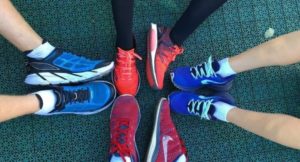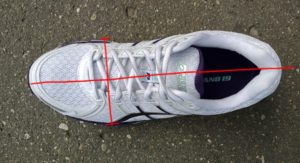At first glance, running seems like a fairly safe sport. Therefore, beginners mistakenly believe that they can do it in any shoes. And only when faced with joint injuries, calluses and sprains do they understand that the choice of running shoes needs to be approached thoroughly.
What shoes are suitable for running?
 The best shoes for running are sneakers. But not every one, but only those whose manufacturing takes into account the structural features of the foot, the distribution of loads during running and external conditions. To choose the right pair from a variety of professional sneakers, you need to answer three main questions. What is the purpose of running? Are there any individual structural features of the feet? Under what conditions will the training take place?
The best shoes for running are sneakers. But not every one, but only those whose manufacturing takes into account the structural features of the foot, the distribution of loads during running and external conditions. To choose the right pair from a variety of professional sneakers, you need to answer three main questions. What is the purpose of running? Are there any individual structural features of the feet? Under what conditions will the training take place?
Criteria for choosing the “right” shoes
Running shoes for competitions should be lightweight with thin soles to develop maximum speed. And for training, they are equipped with a shock absorption system to protect joints from stress.Sneakers must have characteristic features that depend on the way the foot is positioned while running. Let's look at the parameters that need to be taken into account.
Weight
For long-distance running you need to choose heavier shoes, for competitions - lighter. But both of them should not exceed a weight of 300 g. Since every 100 g of weight on the legs increases energy expenditure by 1%.
What should the sole and tread be like?
The sole should be flexible at the toe. For this purpose, manufacturers place special grooves on the sole under the toes. A to reduce abrasion, protective inserts made of more durable rubber are used. The higher the tread, the better the grip.
For soft, unstable soils, shoes with a high tread of up to 8–10 mm are required. For hard ones - medium height (4–7 mm). And the low tread (1–3 mm) is ideal for running on flat, hard surfaces. The tread pattern also affects running efficiency. It must provide the required grip and be easy to clean from dirt so as not to lose its properties.
Running shoe upper
For comfort, the upper part of the sneaker is made soft. Sometimes sewn-in plates are used for greater stabilization. The tongue of the sneaker should protect from dirt and friction of the lacing, and soft pads along the edge should protect the ankle joint from damage.
Material
Preference is given to high-quality synthetic materials that provide lightness and mobility. To ventilate the feet, a mesh is used in the nose or along the entire length. Comfort in difficult weather conditions is provided by membrane fabric that does not allow moisture and cold to pass through.
Buckle or lacing
 As a rule, the lacing is located closer to the inside of the foot to secure it correctly.It is advisable that the holes for the laces were not connected into a single structure. This will allow the sneaker to fit exactly on your foot.
As a rule, the lacing is located closer to the inside of the foot to secure it correctly.It is advisable that the holes for the laces were not connected into a single structure. This will allow the sneaker to fit exactly on your foot.
Some models have special pockets for cords and fasteners to prevent unraveling. Sometimes, instead of a cord, a strong elastic band with a clasp is used, which allows you to tighten and loosen the sneaker in one movement.
Important! No need to worry about tightening the lacing. Restricted blood flow can lead to numbness in the legs.
Back device
To avoid injury, as well as to properly support the foot, running shoes use a rigid heel counter.
Insoles
Must be made of durable, elastic material and have ventilation holes. Antibacterial impregnation prevents the proliferation of bacteria, and as a result, the occurrence of an unpleasant odor. When the insoles in sneakers are removable, they can be replaced with orthopedic ones.
Pronation
 The process of reducing the arch of the foot in contact with the surface, a mechanism of natural shock absorption. This factor must be taken into account in order to compensate for the excess load in the part of the foot affected by the pathology. There are hyperpronation (the arch is reduced, the foot falls inward), hypopronation (high arch, smaller contact area) and neutral (correct placement of the feet).
The process of reducing the arch of the foot in contact with the surface, a mechanism of natural shock absorption. This factor must be taken into account in order to compensate for the excess load in the part of the foot affected by the pathology. There are hyperpronation (the arch is reduced, the foot falls inward), hypopronation (high arch, smaller contact area) and neutral (correct placement of the feet).
Advice! You can determine pronation by looking at your foot print on paper. With normal pronation, the width of the arch of the foot is approximately equal to its width. The absence of empty space in the arch area indicates overpronation; the opposite situation indicates underpronation.
Supination
A movement in which the foot returns to its normal position. An arch support is used to support the arch of the foot.It is a plate curved to the shape of the arch, made of various materials (plastic, metal, etc.).
Important! Only an orthopedic surgeon can help you decide on the type of arch support you need.
Torsional and bending rigidity
The more the shoe curls, the better the feel of uneven running surfaces. And the less such sneakers protect joints from injury. Lateral flexion is important to ensure effective push-off during running.
Depreciation
 Necessary to distribute and reduce vertical impact load. It can be located over the entire surface of the sole or in certain places - on the heel or toe. Manufacturers use different types of depreciation - foam, silicone and plastic inserts or hermetically sealed gas.
Necessary to distribute and reduce vertical impact load. It can be located over the entire surface of the sole or in certain places - on the heel or toe. Manufacturers use different types of depreciation - foam, silicone and plastic inserts or hermetically sealed gas.
The heel strike requires thicker rear cushioning and increased heel-to-toe drop (up to 10mm). And for running, in which the toe drops first, sneakers with cushioning in the front, a thin sole and a drop of up to 5 mm are suitable.
How to choose a size?
The main condition when choosing a size is comfortable foot position. In the right shoes, moving your toes is comfortable. It is recommended to buy sneakers with a small margin in size. Because your legs swell while running. Additional space is needed to place an individual insole or under a warm sock (for activities in the cold season).
Important! In order not to be mistaken with the size, you should take running socks and orthopedic insoles (if available) to the store for fitting. You also need to walk, or better yet, run in sneakers around the store.
The influence of a runner's gender on shoe choice
Constantly wearing high shoes leads to shortening of the Achilles tendons.Because of the height of the heel, the tendon does not need to stretch. Therefore, in women's sneakers, this weak point is additionally protected by a higher heel counter. Also, women's models have a narrower last and a lesser degree of depreciation.
Season, treadmill surface
 In the summer, to prevent your feet from sweating, you need to choose “breathable” sneakers. And in cold times - from denser materials that retain heat. For wet weather, it is recommended to choose shoes made of waterproof fabrics. Running tracks in stadiums have a special rubber coating. It prevents slipping and has good shock-absorbing properties. This allows you to choose shoes with a lower tread height and degree of shock absorption, and therefore lighter weight.
In the summer, to prevent your feet from sweating, you need to choose “breathable” sneakers. And in cold times - from denser materials that retain heat. For wet weather, it is recommended to choose shoes made of waterproof fabrics. Running tracks in stadiums have a special rubber coating. It prevents slipping and has good shock-absorbing properties. This allows you to choose shoes with a lower tread height and degree of shock absorption, and therefore lighter weight.
To run on natural terrain, you need running shoes with medium to deep tread. The sole should be rigid, and the toe should be additionally protected to avoid injury from rocks and other obstacles. When running on ice, it is recommended to use metal spikes.
Advice! Choose models with removable spikes. This will avoid purchasing two pairs for different weather conditions.
How to choose shoes for running and walking on asphalt?
To run on asphalt you need shoes with a high degree of shock absorption. The rubber of the sole should be wear-resistant and provide good grip on the surface.



 0
0





